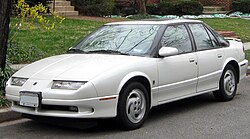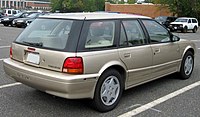Saturn S-Series
| Saturn | |
|---|---|
|
Saturn SL2 (1990–1995)
|
|
| Saturn S-Series | |
| Production period: | 1990-2002 |
| Class : | Compact class |
| Body versions : | Sedan , station wagon , coupé |
| Engines: |
Petrol engines : 1.9–2.0 liters (63–86 kW) |
| Length: | 4399-4585 mm |
| Width: | 1687-1717 mm |
| Height: | 1285-1412 mm |
| Wheelbase : | 2520-2601 mm |
| Empty weight : | 1012-1125 kg |
| successor | Saturn ion |
The S-Series were part of a family of compact cars from automaker Saturn . They were the manufacturer's first vehicles. The vehicle platform, the Z-structure, was completely developed in-house at Saturn and shared very few components with the rest of the General Motors model range. This introduced the space frame, which can also be found on some Pontiac models, which meant that the side panels of the body carried no weight, which meant that plastic parts could be used in place of metal. These polymer parts were dent-resistant - this has long been a main selling point for Saturn.
The S-Series was manufactured from the fall of 1990 to the end of 2002.
From 1990 to 1991 the S-Series was available as SL (“sedan level” = sedan) and SC (“sports coupe” = coupe). The SW ("sedan wagon" = station wagon) was presented in early 1992 at the North American International Auto Show in Detroit.
Taiwan and Japan were the only two Asian countries that imported Saturns. From 1992 to 1996, the first and second generation sedans and the first generation coupes were sold in Taiwan. From 1996 to 2003, the second generation vehicles were offered as right-hand drive in Japan.
All available Saturn models were imported to Canada from 1992.
During a change in autumn 1998, the SC received a small suicide door on the driver's side. This type of door had previously been used in double cab pickups but was an innovation for a coupe.
The S-Series was replaced in 2003 by the larger Saturn Ion , which could not reach the sales figures of the S-Series until the end of its production in late 2007.
Base engine, single overhead cam and manual transmission coupes and sedans were among the most fuel-efficient cars available in the United States at the time, as they were 5.9 L / 100 km in EPA highway tests achieved what, according to today's measurement methods, would probably correspond to about 6.5 L / 100 km.
SL / SW (1990–1995)
The first generation SL and SW were built from autumn 1990 to mid-1995. On the day that then GM CEO Roger Bonham Smith stepped down, the first Saturn left the assembly line at the Spring Hill, Tennessee factory. It was maroon with a light brown interior.
Originally there were two equipment variants. The SL1 had a SOHC-1.9L-R4-LK0 engine that developed 85 PS (63 kW) and was upgraded to the L24 engine with 100 PS (70 kW) in the 1995 model year. The two engines were mechanically identical except for the upgrade from TBI to sequential MPI. The SL2 had a DOHC 1.9L R4 LL0 engine that developed 115 hp (86 kW). Both the SL1 and SL2 achieved 8.1 L / 100 km in the city and 6.7 L / 100 km on the highway.
The Saturns of the model years 1991 and 1992 were available as basic "SL" (only with manual transmission), "SL1", "SL2" and "SC".
For the 1993 model year, the range was expanded to include the SW1 and SW2 station wagons, which were mechanically similar to their SL1 and SL2 counterparts. All models received a revision of the interior in the spring of 1995.
All variants of the S-Series were offered either with a 5-speed manual transmission or with a 4-speed automatic. The automatic transmission offered a performance mode that offered crisper shifts at high revs and a traction setting that allowed more controlled pull-offs by using second gear. The gearboxes of the vehicles with DOHC engines were geared towards acceleration, while the power transmission in the SOHC models was supposed to serve economy.
The S-series had a 45-liter tank, which allowed a range of around 620 km with an average consumption of 7.4 L / 100 km.
SC (1991-1996)
The first generation of the SC was manufactured from the beginning of 1991 to the spring of 1996. Originally, only the SC trim level was available with a DOHC 1.9 L-R4 engine producing 115 hp. From 1993 the previous equipment level was called SC2 and the variant SC1 was introduced. In 1995, the lower area of the front bumper, the reflector on the trunk lid and the interior of the SC2 were revised as part of a minor facelift.
For the 1993 model year, the SC1 was introduced as the entry-level model of the Coupe series. After the SC1 was initially equipped with the SOHC 1.9 L-R4-LKO engine with 85 hp, it was upgraded to the 100 hp L24 engine for the 1995 model year. The first generation of the SC1 did not share the front end with the SC2, which had pop-up headlights, but with the SL models. The SC1 also differed from the SC2 in the lack of a reflector on the trunk lid and the rear cross brace.
Special models
For 1994 a special model called “Homecoming” was launched. It combined pearly white paint with black Saturn emblems, a spoiler, 15-inch “teardrop” rims, four disc brakes with ABS , a gray interior with headrests on the back seat, fog lights, central locking and power windows. A sunroof, CD player and 4-stage automatic were available at an additional cost. A total of around 3500 copies of this special model were produced.
In 1998 and 1999, potential buyers had the option of ordering the Black Top Coupe Package for $ 225. These models were called “Red Hot Coupe” or “White Hot Coupe” depending on the exterior color. The package included a black roof, black exterior mirrors, black emblems, white instruments and black accented teardrop rims. These are extremely rare.
Production numbers of these special models:
- Model year 1998
White: 213 Red: 657
- Model year 1999
White: 285 Red: 284
In 1999 a second “Homecoming” edition was also sold, featuring a special “mint color”, light brown leather interior, special cream colored displays and black Saturn logos to commemorate the second homecoming to the Spring Hill factory. The same equipment was offered for the 4000 vehicles produced in this special model as for the first "Homecoming" edition from 1994.
In 2001 a special yellow Coupé SC2 was also built. The 99 copies of this special model called “Bumblebee Edition” were delivered with a certificate of authenticity. The “Bumblebee Edition” included wider headrests, a black leather interior with yellow leather inlays on the seats and doors. It can be distinguished from the normal yellow coupes.
In addition to the special models mentioned, there were 450 right-hand drive Saturn SWP “Post-Kombis” in 1999, which were intended for postmen in rural areas.
SL / SW (1995-2002)
The second generation SL and SW were built from mid-1995 to the end of 2002.
The redesign led to a more rounded appearance of the SL and SW combined with a slight enlargement of the interior and entrance. Mechanically, very little changed from the previous model, although 1996 was the first year for the OBDII PCM.
For the 1999 models, improvements to both SOHC and DOHC engines did not result in more power, but made the engine run less smoothly. These changes included revised pistons, connecting rods, crankshafts, and more. The consumption values of these optimized models also improved.
The facelift made in autumn 1999 included some changes to the interior and polymer body parts, which increased the length of the vehicles by 3 centimeters, although the technology remained practically unchanged.
SC (1996-2002)
The second generation of the SC was offered from summer 1996 until the end of 2002.
With the second generation, the wheelbase of the SC was increased to the length of the SL / SW models. The redesign led to a more rounded appearance of the SC combined with a slight increase in the interior space and entry. Technically, very little has changed compared to the previous model.
In the fall of 1998 a small suicide door was added on the driver's side. Although this allows passengers to reach the back seat without having to move the driver's seat, this additional door was mainly intended to make it easier to stow luggage behind the driver's seat, which is why the position of the handle in the door frame means that it can only be opened when the driver's door is open .
In contrast to the SL and SW, only the interior was changed as part of the facelift in autumn 1999, as the exterior was only slightly redesigned a year later.
theft
According to the CCC Information Services' Most Stolen Car Report, the 1995 Saturn SL was the most stolen car in the United States in 2003, while the 1994 SL was third. According to the Lynnwood Police Department , wear and tear on the key on the locking and ignition mechanisms can allow a blank key to unlock and start the car.
successor
The successor to the S-Series from 2003 was the Saturn Ion . Unlike the S-Series, this was no longer a complete in-house development by Saturn, but shared the platform and engines with other GM models such as the Chevrolet Cobalt or Pontiac G5 . Its successor, the Saturn Astra , also continued to use this platform.
Production numbers
The following production figures are from "The Encyclopedia of American Cars" by the Auto Editors of Consumer Guide, Copyright 2002.
| 1991 | 48.629 |
| 1992 | 169,959 |
| 1993 | 244,621 |
| 1994 | 267,518 |
| 1995 | 302.988 |
| 1996 | 294.198 |
| 1997 | 314,992 |
| 1998 | 219.765 |
| 1999 | 275.633 |
| 2000 | 169.866 |
| 2001 | 117.842 |
| 2002 | k. A. |
swell
- ↑ 1995 Saturn SL Tops Most Stolen Vehicle List . In: saturnfans.com/ . Retrieved April 3, 2008.







